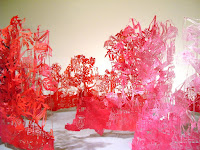2005 hanging installation, Hand cut paper, ink, thread and glass beads
Height of paper cuts 90 cm, width and depth variable


2004, Floor installation, Hand cut paper, ink, perspex rods, acetate
Made from an assortment of hand cut paper plants and trees grouped together to mimic the man made natural space of a garden, “An establishment for the diffusion of knowledge” presents the constructed natural landscape as a place where information can be obtained and our cultural identity contemplated.
“An establishment for the diffusion of knowledge” is a floor-based installation depicting a diorama of a constructed natural space, a garden. Made from a collection of hand cut paper plants and trees, the work explores the significance of a garden as a place where information can be obtained and our cultural identity contemplated. Imagery in the cutout detail of the leaves references the development of Melbourne as a city; together the trees will provide information about the cultural aspects of the grater landscape (or cityscape) it is located within, placing emphasis on the cultural and historical significance of such natural spaces.
In an urban landscape, the tree appears vulnerable and dispensable, its permanence is susceptible to the greater force of town planning, its significance seems so subtle that it is unnoticeable alongside the bold, attention grabbing slogans of contemporary culture. The installations dwarfed scale and ephemeral appearance parallels the vulnerability of the natural landscape, the handcrafted materials emphasise time, history and the details that can be found upon careful observation.






